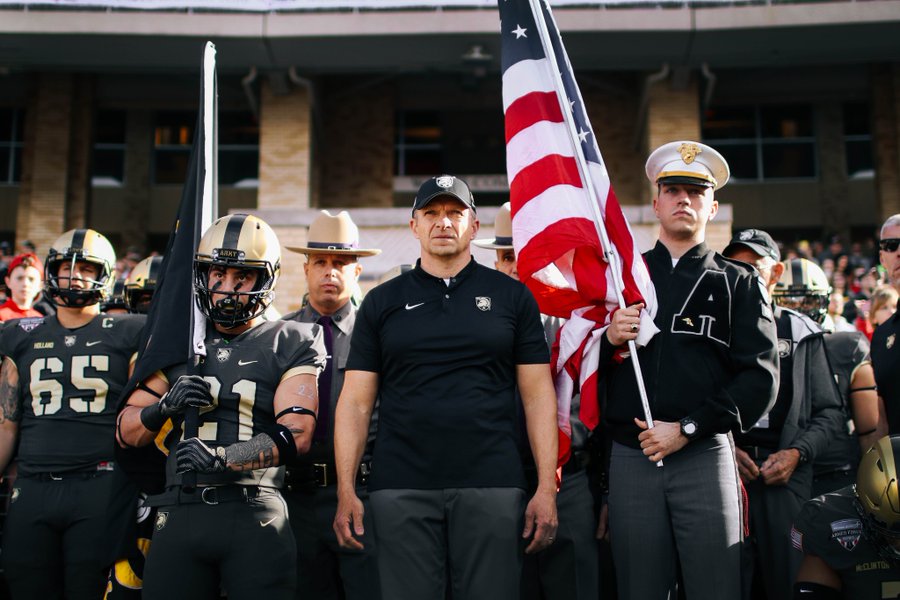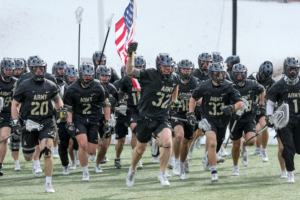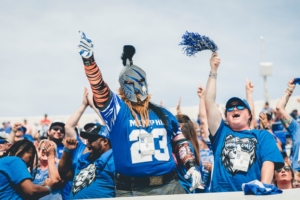This is the fourth entry in this year’s Army Football 101 series. This week we highlight Army’s defense. If you missed any of our previous entries, we’ve archived them here:
Army Football 101: The Triple-Option
As For Football’s Guide to Michie Stadium
5 Traditions that Make Army Football Great
Emblem Athletic Sponsors As For Football
We’ll wrap the series in two weeks with a look back at Army vs. Rice (2016). If you want to get a jump on things, this link will take you to an archived YouTube video of the game. Watch it now to get prepared for our discussion in two weeks.
Overview
Defense wins championships, but it’s hard to play lockdown “D” without elite defenders. All things being equal, a team’s defense tends to have many of its most athletic players, with pass-rushers in particular requiring a unique blend of size, strength, and big-play burst. Army, though, has a relatively small number of high-end athletes, especially high-end athletes with elite size and speed. The Academy’s physical requirements can make it difficult for guys to get and stay big, and more to the point, West Point’s service commitment scares away many high-talent prospects, even mid-range three-star recruits whose odds of making the NFL are statistically negligible. Like its offense, then, Army’s defense needs a scheme that compensates for the team’s realities while leveraging its unique strengths.
Army’s defense cannot necessarily square up against better college offenses by playing press man coverage on the outside while relying on its front four to get pressure. This means that they can’t necessarily contest every single yard on the field. But the Black Knights have smart, highly disciplined players who can be relied upon to be in the right spot doing the things, and that’s not nothing.
Don't worry… @philsteele042 didn't forget our defense going into 2019.#GoArmy pic.twitter.com/F2GhK5K22k
— Army Football (@ArmyWP_Football) June 13, 2019
Base Defense: 3-4 Scheme
We broke down the offense a few weeks ago in a uniquely military way, arguing that the Fullback Dive serves as the offense’s fixing attack, holding the opponent’s defense in place in the middle while the Quarterback Keeper and Option Pitch generally attack the edges. The Black Knights’ 3-4 defensive scheme is similar in the sense that the three defensive linemen—a nose tackle, defensive tackle, and defensive end—serve primarily to fix the offensive line in the middle while the linebackers—two inside and two outside—stop the run and get pressure on the quarterback.
Ideally, the outside linebackers get around the edges and rush the passer while the inside linebackers stop the run and cover short passes over the middle. In Army’s case, though, this is hardly a given. Because the Black Knights have such smart, disciplined players, they can afford to trade off responsibilities and mix up coverages in the front seven through a huge variety of formations. This allows them to bring blitz pressure from many different locations and angles against many different offensive fronts. This in turn creates confusion amongst an offense’s blockers.
Then, too, it’s not like the defensive line isn’t trying to stop the run and hit the quarterback. Remember: it’s a good thing when one’s fixing attack gets penetration. This particular scheme, however, is mostly trying to stop the run while freeing a blitzing linebacker to come free for a sack. The use of formations and stunts aids this effort by pulling blockers out of position, thereby creating rush lanes for the blitz (Much more on Army’z blitz schemes here).
Essentially, the use of formation acts as an Economy of Force effort, pulling an excess of blockers to one side against a relatively small number of pass rushers. This creates a rush lane on the other side of the play, though it relies entirely on Army’s defenders understanding how the opposing offense is trying to attack the defense.
It’s worth noting that Army’s linebackers, especially their inside linebackers, have a tremendous amount of responsibility in this defense. Not only do they have to make the plays that the rest of the defense sets up, they also have to ensure that their teammates are lined up correctly in anticipation of the coming play. It’s no surprise, then, that at least one inside linebacker is almost always elected a team captain, too. The defensive scheme itself maximizes the impact of Army’s intelligence and discipline while minimizing the impact of specific athletic mismatches. This is how Army wins on both sides of the ball, but it requires at least as much leadership as it requires sheer athleticism.
Our inside BACKERS combined for some ridiculous stats this year!#GoArmy pic.twitter.com/HGTsQgIzPb
— Army Football (@ArmyWP_Football) January 11, 2019
Career high 16 tackles.
3.5 sacks.
3 force fumbles.Those numbers land James Nachtigal on AP All-Bowl Team.#GoArmy pic.twitter.com/6Zh0Wp8GfI
— Army Football (@ArmyWP_Football) January 4, 2019
Bend But Don’t Break
Army plays two safeties and two cornerbacks in its base secondary, though it’s expected to play more nickel defense going forward, bringing on a fifth defensive back—a slot cornerback—in lieu of a linebacker. Occasionally, we’ll see a dime defense with six defensive backs and only two linebackers as well, but that’s generally only in long passing situations.
Regardless of the personnel package, Army’s secondary is primarily trying not to get beat deep. Because of the way the team plays offense and because of the inaccuracies inherent in college passing offenses, the Black Knights are generally content to give up quick passes to the outside in order to avoid giving up long plays over the top. Reality is that with rare exceptions, the Black Knights just do not have enough athleticism in their secondary to cover elite wide receivers one-on-one in press coverage. However, the overwhelming majority of college quarterbacks cannot routinely complete more than 60% of their passes. Sure, New England Patriots QB Tom Brady can dink-and-dunk his way down the field with a bunch of short three and five yard passing plays, but he reads defenses perfectly and possesses a unique passing accuracy that is well beyond the abilities of even elite collegiate-level players. Army is not going to face that level of talent very often, and their defense reflects that reality.
If the Black Knights can stop an opponent’s running game and avoid getting burned for long touchdown passes, simple statistics will reliably create at least one 3rd down and long situation in every opposing offensive drive. College quarterbacks are simply not accurate enough on average to win with quick outs.
Army’s blitz-heavy defense is very good on 3rd-and-long by design. But those 3rd down situations are often created despite allowing opposing offenses to gain good yardage on average 1st and 2nd downs. In most cases, the Black Knights are just trying to fend off disaster long enough to allow the opposing team to make a mistake. Given smart, disciplined players, this Army team has become very good at taking advantage of those inevitable mistakes. Add in the pressure that Army’s offense puts on opposing offenses through its time-of-possession advantage, and even a small number of opposing offensive mistakes can give the Black Knights a huge advantage in games.
Our 2018 Corners were BALLHAWKS! #GoArmy#CornersWeek pic.twitter.com/Uvkv0atqIG
— Army Football (@ArmyWP_Football) May 29, 2019
Red Zone Defense
As an offense approaches the goal line, the field shortens, and elite speed matters less. Army’s defense becomes much less likely to get beat over the top, which allows the team to bring more pressure while playing much tighter coverage on the outside.
Army’s defense has been very good in the red zone under Head Coach Jeff Monken. They’ve become a tough, disciplined unit that understands exactly what opposing offenses are trying to do. Freed from the constraint of getting beat by superior speed, this defense becomes truly elite, forcing field goals and turnovers while allowing a relatively small number of touchdowns, especially passing touchdowns. This is often the difference in games, especially once we factor in Army’s offensive efficiency and time-of-possession advantage on offense.
In 2018, Army ranked 20th in overall red zone defense, giving up just 11 rushing touchdowns and 9 passing touchdowns from the red zone all season. This despite playing several of college football’s most prolific offenses, including college football’s very best in Oklahoma.
Here are the highest-graded linebackers from the 2018-19 postseason. pic.twitter.com/W7VqsJu7ta
— PFF College (@PFF_College) January 11, 2019
Final Thoughts
Army’s defense will never win on style points. They give up too much yardage on 1st and 2nd downs to rank in overall defense or in generic defensive metrics like ESPN’s Football Power Index (FPI) or Football Outsiders’ S&P+. That’s just not the way this defense is built. However, if the team can avoid getting beat over the top, and they can play good red zone defense, then they aren’t going to give up a lot of points regardless of all other factors. Army’s defense plays its best in the most important situations, and that has typically been enough to give them a chance to win, even against elite competition.
Sources
Nicole Auerbach, “State of the Program: Army has something to defend and something to build on,” The Athletic: June 8, 2019.
Seth Galina, “Learn how Army’s Defense was a Knightmare for opposing offenses this season,” USA Football: January 7, 2019.













